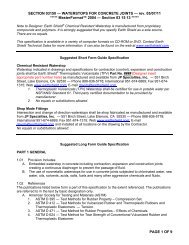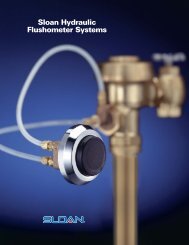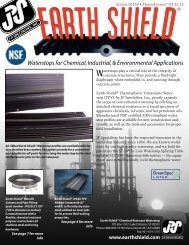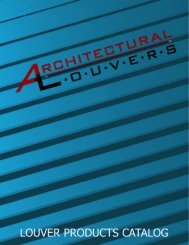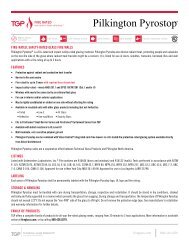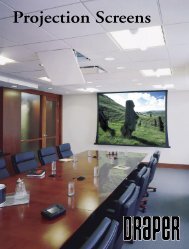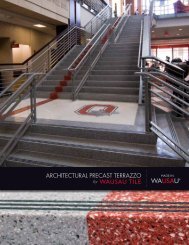National Gypsum Construction Guide
National Gypsum Construction Guide The entire - AECinfo.com
National Gypsum Construction Guide The entire - AECinfo.com
- No tags were found...
You also want an ePaper? Increase the reach of your titles
YUMPU automatically turns print PDFs into web optimized ePapers that Google loves.
Gold Bond ® BRAND <strong>Gypsum</strong> Wallboard<br />
DESCRIPTION<br />
TECHNICAL DATA<br />
RECOMMENDATIONS<br />
09 29 00/NGC<br />
BUYLINE 1100<br />
<strong>Gypsum</strong> board is the name for a<br />
family of board products<br />
consisting of a<br />
noncombustible core,<br />
primarily of gypsum, with a<br />
paper surfacing on the face,<br />
back and long edges.*<br />
The popularity of gypsum<br />
wallboard results from a<br />
number of factors. First, it<br />
takes virtually any<br />
decoration – from paint or<br />
textures to vinyl and paper<br />
laminates. It also lends itself<br />
to creative shaping of<br />
interior surfaces, allowing<br />
the maximum in design<br />
flexibility. <strong>Gypsum</strong><br />
wallboard is an economical<br />
alternative to other products.<br />
Because it is lightweight, it is<br />
easy to handle for speedy<br />
installation. With its natural<br />
properties, it is durable yet<br />
easy to repair. In addition,<br />
gypsum wallboard’s fire<br />
resistance and sound control<br />
capabilities further<br />
demonstrate its desirability<br />
in building systems.<br />
Ever conscious of the<br />
environmental challenges<br />
we face in today’s world,<br />
<strong>National</strong> <strong>Gypsum</strong> produces<br />
its wallboard with 100<br />
percent recycled paper on<br />
both the face and back.<br />
Gold Bond gypsum wallboard<br />
is available with a variety of<br />
edge configurations. For easy<br />
joint finishing, the tapered<br />
edge is preferred to provide<br />
a monolithic surface. Where<br />
joints will be exposed,<br />
square or beveled edges<br />
should be considered.<br />
<strong>National</strong> <strong>Gypsum</strong> also<br />
manufactures wallboard<br />
with proprietary edge<br />
configurations made to<br />
accommodate a variety of<br />
wall systems and finishing<br />
techniques.<br />
*GA-216<br />
Fire and sound ratings for<br />
building systems utilizing<br />
gypsum wallboard are<br />
dependent on the core type<br />
and thickness of the<br />
wallboard, its application in<br />
conjunction with the<br />
component parts, and the<br />
manner in which it is<br />
applied.<br />
Tests for fire resistance and<br />
sound transmission,<br />
performed by independent<br />
laboratories, have resulted in<br />
specific ratings for walls/<br />
partitions; floor/ceiling<br />
assemblies; shaftwalls,<br />
stairwells and area<br />
separation walls; and<br />
columns. For maximum fire<br />
resistance and sound control,<br />
double layer construction is<br />
generally recommended<br />
since the additional mass<br />
further retards heat and noise<br />
penetration.<br />
<strong>Gypsum</strong> wallboard can be<br />
installed to both metal and<br />
wood framing using nails,<br />
screws or adhesives in<br />
combination with nails or<br />
screws. In many instances,<br />
the application will dictate<br />
which fastening method is<br />
appropriate.<br />
Control joints may be necessary<br />
to prevent cracking in the<br />
gypsum wallboard facing of<br />
drywall systems, especially<br />
in areas where structural<br />
elements such as slabs,<br />
columns or exterior walls<br />
can bear directly on nonload-bearing<br />
partitions. To<br />
relieve the stresses which<br />
occur as a result of<br />
movement induced by<br />
changes in moisture,<br />
temperature or both, control<br />
joints are required in both<br />
partitions and ceilings.<br />
GYPSUM BOARD<br />
INSULATING PROPERTIES<br />
For purposes of calculating<br />
“U” values, the “C” factor for<br />
1" gypsum board is 1.2;<br />
Resistance “R” for 3/8" board<br />
is .32; for 1/2" board .45; for<br />
5/8" board .56 and for 1"<br />
board .83.<br />
Examine and inspect materials<br />
to which gypsum board is to<br />
be applied. Remedy all<br />
defects prior to installation of<br />
drywall. Any defects in the<br />
finished installation due to<br />
misaligned framing or other<br />
cause will be the<br />
responsibility of the work<br />
performed under that section<br />
of the specification and such<br />
defects shall be remedied<br />
under that section of the<br />
specification.<br />
<strong>Gypsum</strong> wallboard shall be<br />
applied first to ceiling at right<br />
angles to framing members,<br />
then to walls. Boards of<br />
maximum practical length<br />
shall be used so that an<br />
absolute minimum number<br />
of end joints occur. Board<br />
edges shall be brought into<br />
contact with each other but<br />
shall not be forced into<br />
place.<br />
Wallboard joints at openings<br />
shall be located so that no<br />
end joint will align with<br />
edges of opening unless<br />
control joints will be<br />
installed at these points. End<br />
joints shall be staggered, and<br />
joints on opposite sides of a<br />
partition shall not occur on<br />
the same stud.<br />
<strong>Gypsum</strong> wallboard shall be<br />
held in firm contact with the<br />
framing member while<br />
fasteners are being driven.<br />
Fastening shall proceed from<br />
center portion of the<br />
wallboard toward the edges<br />
and ends. Fasteners shall be<br />
set with the heads slightly<br />
below the surface of the<br />
wallboard in a dimple<br />
formed by the hammer or<br />
power screwdriver. Care<br />
shall be taken to avoid<br />
breaking the face paper of<br />
the wallboard. Improperly<br />
driven nails or screws shall<br />
be removed.<br />
See page 61, Environmental<br />
Conditions and Limitations.<br />
CURVED SURFACES<br />
To apply wallboard over a curved surface, place a stop at one end of<br />
the board and then gently and gradually push on the other end,<br />
forcing the center against the framing until the curve is complete.<br />
Shorter radii than shown in the table may be obtained by moistening<br />
the face and back papers of the board with water, stacking on a<br />
flat surface, and allowing the water to soak into the core for at least<br />
one hour. When the board is dry it will regain its original hardness.<br />
<strong>Gypsum</strong> wallboard may be applied to curved surfaces in accordance<br />
with the following:<br />
WALLBOARD BENDING RADII<br />
Thickness Bending Lengthwise Bending Widthwise<br />
1/4" (6.4 mm) 5'-0" (1524 mm) 15'-0" (4572 mm)<br />
3/8" (9.4 mm) 7'-6" (2286 mm) 25'-0" (7620 mm)<br />
1/2" (12.7 mm) *10'-0" (3048 mm)<br />
5/8" (15.9 mm) 15'-0" (4572 mm)<br />
*Bending two layers of 1/4" (6.4 mm) board successively will permit a bending<br />
radius shown for 1/4" (6.4 mm) board.<br />
Note: To achieve tighter bending radii, use Gold Bond 1/4" High<br />
Flex Wallboard. See page 74 for additional information and 1/4"<br />
High Flex minimum bending radii chart.<br />
SURFACE BURNING CHARACTERISTICS<br />
(Fire Hazard Classification) Tested in accordance with ASTM E 84<br />
<strong>Gypsum</strong> <strong>Gypsum</strong> Durasan<br />
Wallboard Sheathing All Standard Patterns<br />
Flame Spread Index 15 20 25 or less<br />
Smoke Developed 0 0 50 or less<br />
09 29 00<br />
SPECIFICATIONS<br />
THE FOLLOWING PARAGRAPHS ARE FOR INSERTION INTO SECTIONS OF GENERIC SPECIFICATIONS OR GENERIC/PROPRIETARY SPECIFICATIONS COVERING GYPSUM<br />
WALLBOARD PRODUCTS. THE NATIONAL GYPSUM PRODUCT NAME FOLLOWS THE GENERIC DESCRIPTION IN PARENTHESES.<br />
PART 2 PRODUCTS 2.01 MATERIALS<br />
A. Regular <strong>Gypsum</strong> Board: A gypsum core board that is fire resistant and surfaced with paper on front/back and long edges and complies with<br />
ASTM C 36/C 1396.<br />
1. Thickness: 1/4", 3/8", 1/2" (Gold Bond BRAND <strong>Gypsum</strong> Wallboard) 3. Length: 6' through 16'.<br />
2. Width: 4'. 4. Edges: Square, Tapered, or Beveled Tapered (Sta-Smooth Edge).<br />
PART 3 EXECUTION 3.01 INSTALLATION<br />
A. General: In accordance with the manufacturer’s recommendations, <strong>National</strong> <strong>Gypsum</strong> Company “<strong>Gypsum</strong> <strong>Construction</strong> <strong>Guide</strong>.”<br />
NATIONAL GYPSUM WALLBOARD PRODUCTS<br />
63



